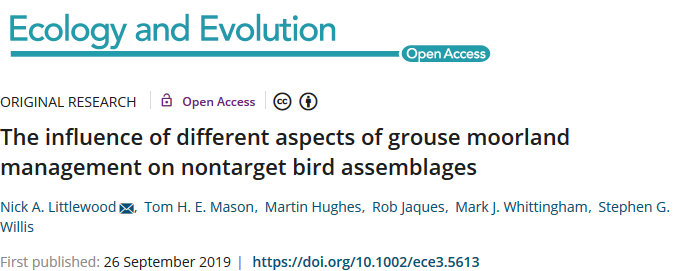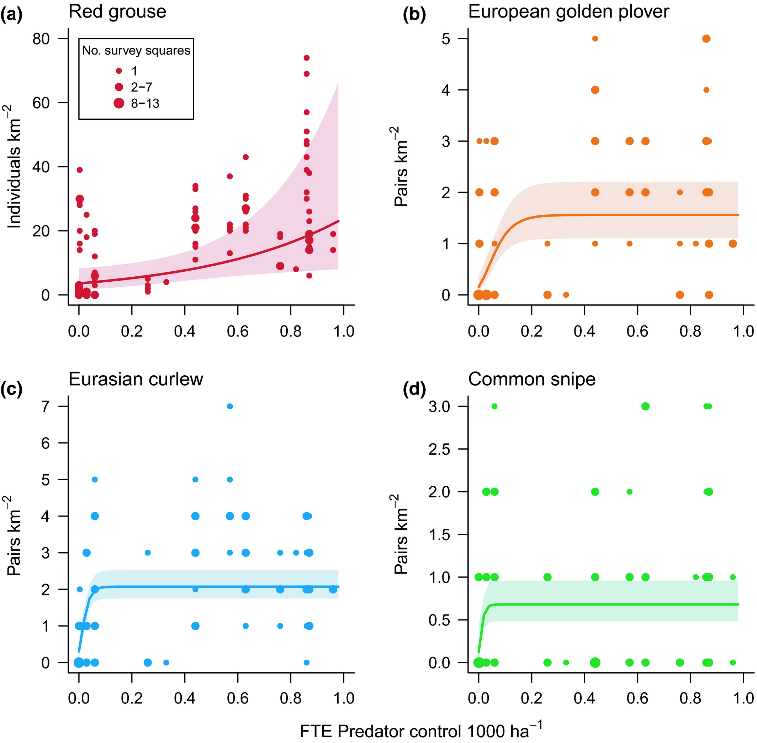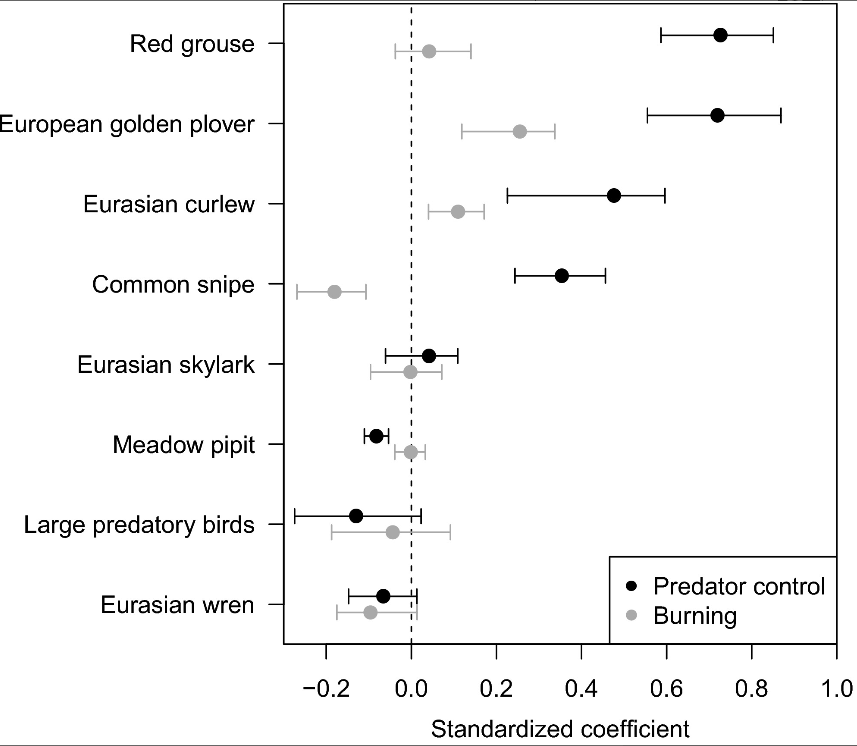
This study has cropped up before on this blog (partly because of the unusual secrecy about who funded it – see here and here) and partly because of the fact that it has been ‘quoted’ by grouse shooting interests in the past before it was published. Now it is published and the grouse shooting industry has been very coy about it – I haven’t seen them mention it at all. How odd when they were shouting about it before the data were analysed and published. How could that be?
Also, the researchers involved promised to tell me when the study was published but they haven’t. It must just have slipped their minds.
But what does the paper say? It says that the more predator control there is on grouse moors the more pairs of Red Grouse there are in spring, but that the impacts on numbers of waders are much less. Predator control does appear to help increase wader numbers (as we accept from previous studies) but the maximum impact is reached at far lower levels of predator control than are practised on most grouse moors (at least most grouse moors in their sample – more on the sample later, below). Massive levels of predator control help deliver large bags (or in this study large spring densities) of Red Grouse but very much lower levels of predator control would be fine for waders (Golden Plover, Snipe and Curlew).
This finding is best illustrated by this diagram;

So, predator control does help breeding wader densities on grouse moors (as we know) but the level of predator control practised on those moors is far higher than that which would be necessary to benefit those waders.
How about burning?
This study finds that burning doesn’t make much difference at all to densities of anything on grouse moors – not even Red Grouse apparently. This comes as a bit of a shock to me, but not nearly as much of a shock as it will be to grouse moor managers.

The paper isn’t mealy-mouthed about this;
we found little support for a strong influence of burning on upland bird species
https://onlinelibrary.wiley.com/doi/full/10.1002/ece3.5613
This is just one study but it is quite interesting. Burning isn’t that important? It’s no good for Red Grouse and it’s bad for Snipe, but it’s a bit good for Curlew and good for Golden Plover? That’s a bit of shocker for the grouse shooting industry, isn’t it?
I think I can see why the grouse shooting industry is not shouting about this paper.
++++++++++++++++++++++++++++++++++++++++++++++++++++++++++
A few other points:
- The funders are not disclosed here – merely that the funding came from the Charities Aid Foundation (a reputable body). However, in touting for academic researchers to do this study it was revealed that the source of funding was the grouse shooting industry. If this was so, as I believe it is, then shouldn’t the authors have disclosed this in the conflict of interest section?
- At the moment, although the paper is public access (excellent!) there are no details given of the localities studied or how they were selected. This is a bit unusual. Let us just imagine that the study was funded by grouse shooting interests – what say did they have (eg by enthusiastically offering bits of land for survey) in choosing the study sites? I’ve requested the dataset to see whether that information is disclosed – it should be.
- My statistical acumen is now 20 years out of date, but the fact that there were only ‘really’ 18 sites involved in this survey (and we don’t know how they were chosen) is a bit worrying to me. I’ve read the Methods and Results sections carefully and I can see that there is a load of stuff (which I don’t understand) that addresses the possibility of pseudo-replication but I’d very much value the views of some bright scientists on this.
- I note that the paper was accepted on 3 August this year. I didn’t know that, of course, but I did email one of the authors on 6 August as follows ‘I haven’t heard from you on this paper – is it accepted or published yet please? i note tht we are approaching the Inglorious 12th. many thanks‘ and got an out-of-office reply and no follow up.
Surely, if the grouse shooting industry had any sense they would be delighted to learn that burning appears not to increase grouse numbers and would be happy to do a lot less of it. It’s very bad for the environment, unpopular with the public and will become much more so.
Sadly, they are as wedded to tradition as the pastoralists we encountered in Madagascar, where erosion was the worst I have seen and the estuary we explored was full of the washed off soil. As we watched the grasslands burning, our guide explained that this was a bad practice but the people had always done it and would not change.
I frequently use what’s happening in Madagascar with cattle grazing to point out not all problems are to do with multi nationals and western style consumption – shitty ‘traditional’ farming techniques can be massively and unnecessarily destructive too, but politically awkward to deal with so too often a blind eye is turned. We could achieve so very, very much more if it wasn’t (pussy footing about trying to reform traditional Chinese medicine when it needs booted into the long grass doesn’t help either – thinking rhino horn will cure your cancer isn’t good for rhino or people). The amount of money that’s gone to Madagascar to aid conservation is staggering hundreds and hundreds of millions of dollars, with pretty much sod all to show for it – of course the future of the Malagasy people is being lost with the soil and wildlife too. If I was actually offered a free trip to Madagascar I think I might turn it down because the reality would put me in a deep, dark depression.
Les – very interesting. I was there about 12 years ago. It was very obvious that in some cases the wildlife tourism income wasn’t benefitting the local community as it might have done. It was a great trip with some fabulous wildlife but some of the areas that held the key birds etc. were pitifully small. The low point was the spiny forest being cut down around us by the villagers while our local guide located the special birds.
Aye there was a study of eco tourism in Tanzania recently which showed the locals weren’t benefiting from it as much as they should. Some years ago WWF sponsored an agricultural scheme (Betsileo province I think) where locals were shown how to do a better job of growing rice so that they would shift away from really damaging use of cattle. It was a brilliant success – far more food was produced at a fraction of the ecological cost (including amount of land used) of beef production. The families even had more rice to sell and thereby boost their income and improve their standard of living. And what did they do with the new funds? They promptly went out and bought more cattle – the size of your herd is a display of wealth. Sometimes the problem is very, very basic, but for some reason difficult to raise from a political viewpoint – but it’s not going to go away.
Hi
Like your term “wedded to tradition”
Looking at the ranges shown in the burning diagram it appears that in some cases burning actually reduced the number of Red Grouse and also in some cases increased the number of large predatory birds.
Not sure that owners of driven grouse moors would be thrilled about either!
I noticed the same thing. What a pity they chose error bars instead of dotting in the actual values, as we could then have seen the extreme cases, which might have been considerably deviant from the mode.
Just noticed they are ‘ranges’, not ‘error bars’. So we are seeing the extremes, in fact
These findings are hilarious, especially in the context of the earlier (seemingly premature) commentary from well known scientist Ian Botham.
But you need to speak to George Winn Darley. He told a group of us attending a Heather Trust seminar on Goathland Moor in Sept, and I quote,
“You might think the primary reason we burn heather is for grouse shoot management. It isn’t! The primary reason we burn heather is for wildfire management”.
When asked by a local guy (Richard Gray) if George could perhaps explain to the group some of the negatives of heather burning, GWD pursed his lips, shook his head for a few seconds and said:
“Er, no, I can’t think of any”.
It won’t come as a surprise to anyone to learn that George is the regional Moorland Assoc rep.
It was a fascinating day – I really should blog about it, especially George’s views on why hen harriers haven’t nested in the NYM National Park for so long!
I don’t understand “coefficients” or “predictors”, never mind “saturating non linear effects”,
but Heather burning not increasing grouse numbers is plain crap, unless you are working
within very narrow parameters.
So you don’t understand the methods, assumptions and reasoning, but the answer is crap? That’s going to carry some authority…..
your chosen ‘name’ says all we need to know about you I think, doesn’t it?
abuse the messenger rather than take note of the message – mature and erudite. And by the way, what are you trying to say with your name?
To the uninformed, reading Mark’s brief interpretation of the burning section of the study, it
would seem that gamekeepers have been wasting their time for the last 150 or so years.
All else being equal, under burning, or over burning, will lead to a decrease, in the carrying
capacity of a moor.
Some point in between ,dependant on the ground in question, will be the optimum.
Mark, I know, understands this.
TRapit – except that isn’t exactly what the paper says is it?
It does, on the face of it, seem surprising that burning was not found to have a positive impact on grouse numbers. There appears to be a credible biological explanation for why it would benefit grouse and presumably the spread of the practice was based on some kind of evidence of effectiveness (albeit, not necessarily based on rigorous statistical analysis). (Having said that many things were practised for many years in the past (e.g. blood-letting) before eventually being shown to be either of no benefit or, worse, actually harmful).
Might it be the case that the paper’s conclusions regarding the impact of burning were influenced by the measure the authors used for burning in their models? Whereas predator control was measured in terms of intensity, burning was measured as the area within each survey square under burning management as assessed from Google Earth images. If I understand correctly, the authors indicate the expectation that burning within a prior twenty year period would be detectable. Potentially, quite different management regimes in terms of the frequency of burning may have been lumped lumped together in one measure. It MAY be possible therefore that Trapit has a point and that the ‘right’ frequency of burning could be beneficial to grouse but the wrong frequency not.
Of course, even if burning does increase the number of grouse available to be shot, the ‘value’ of this needs to be considered in the light of other impacts of burning such as carbon loss, increased flood risk and water quality issues.
Jonathan (and Trapit) – I’ve been mulling this over. I’m not sure what the answer is and one possibility is that burning isn’t as important as people think. But maybe another is that burning has a beneficial impact on Red Grouse chick survival (short term!) but that enough Red Grouse are shot (because that is what they are there for on grouse moors) that this does not feed into spring densities the next year (which is what was measured). It’s difficult to know isn’t it?
Indeed, and I agree that the paper’s conclusion, surprising though it is, could well be correct. I was speculating on potential reasons why a counter-intuitive result was obtained and one of the other possibilities is that any effect of burning was somehow masked as a result of the methodological choices made during the study.
Admittedly I have not read the entire report (only the brief summary above), but will
endeavour to do so.
Saying the funds came from CAF is like saying it came from NatWest or a Swiss bank. It’s just a way of hiding who paid for it, and shouldn’t be allowed. If it was grouse shooting interests, the authors should certainly have addressed the question of conflict of interest, though at first sight, it doesn’t seem to have stopped them producing results which will be very unwelcome to such interests!
The money comes from a wide range of sources, individuals, organisations, religious types, etc. The Trust gives 100 of thousands of pounds to charity conservational projects every year, quite why we keep doing this is a red rag to bull to me, especially when I meet these incompetent clowns. My argument has always been that this money is better spent on our rewilding project than going into individual salaried pockets for a 3 year funding project.
For once I do agree with Dr Avery, we have to stop this burning especially if the data is inconclusive, it could be a positive start to reforming grouse moors and their management, which is the only sensible conclusion to this impasse.
I’m not surprised by the results of the predator control as regards Red Grouse and wader numbers.
We’re looking at something very different. With Red Grouse the shooters just want plenty of Red Grouse to shoot. It is not about having a large sustainable population. It’s just about producing a large transient population of young birds, a large proportion of which are shot.
Whereas with waders it’s about having a large population of long lived adults which live relatively long lives and which breed many times.
Those arguing that intense predator control is necessary to help waders are wrongly assuming that the success of waders is just about avoiding predation at the nesting phase. This is self-evidently not true.
My experience is the same Ruth that gamekeepers and estate managers argue vociferously that burning of Heather is needed more importantly for wildfire management. In fact there was a planning application for a 5 km track across Blanket Bog on a rather notorious Grouse Moor in West Yorkshire that used this as its main argument for approval.It received the backing of the West Yorkshire Fire Brigade, an unlikely bedfellow of D.G.S ! Thankfully this application was turned down due to the negative environmental impacts but not before a hard won battle. Worth bearing in mind for future battles against development on Grouse moors.